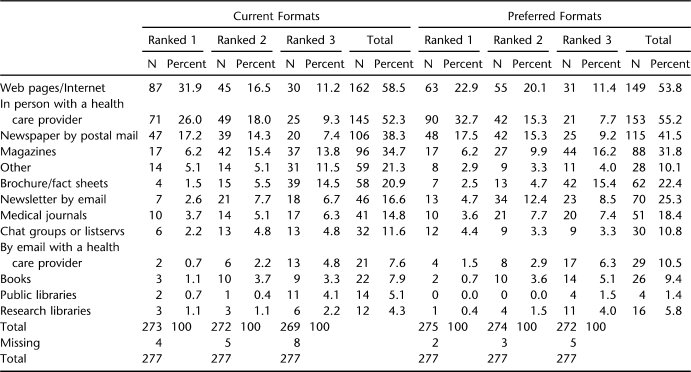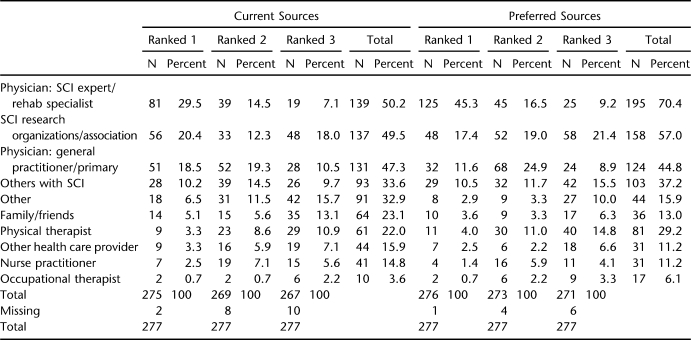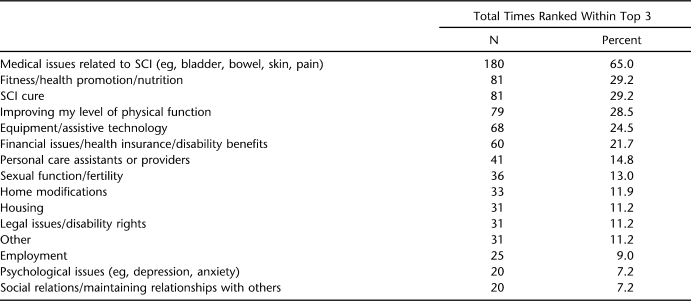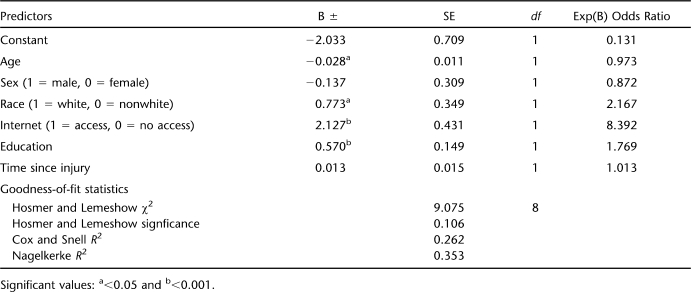Abstract
Background/Objective:
To determine the information needs, level of Internet access, and current and preferred formats and sources of information of adults with spinal cord injuries (SCIs). Individuals with SCIs have a high lifetime risk for medical complications and other health conditions secondary to their injury. Many secondary conditions can be prevented or mitigated through appropriate self-care and/or self-management. People with SCIs need timely, high-quality information about health and medical issues after discharge and throughout their lifetime to improve self-care and maximize quality of life.
Methods:
A survey was administered as part of the third time point of a longitudinal research study on individuals with SCI.
Results:
A total of 80.2% of the 277 respondents reported having Internet access. The most frequently selected format used currently and preferred by respondents for receiving SCI information was “Web pages/Internet.” The top-ranked current and preferred source of SCI information was from a “Physician: SCI Expert/ Rehabilitation Specialist.” Respondents reported needing information on medical issues the most. Significantly higher percentages of individuals identified as “white” and with higher education levels had access to the Internet and ranked the selection of Web pages/Internet as their top choice.
Conclusions:
Results confirm that, although people with SCI prefer to receive SCI information from SCI experts, the Internet is a more accessible and more currently used source. Educational level and race predicted current and preferred use of the Internet for obtaining SCI information, suggesting that Internet distribution of SCI information will exclude subgroups.
Keywords: Spinal cord injuries, Rehabilitation, physical, Disability, Prevention, Model spinal cord injuries system, Information needs, Patient education, Information-seeking preferences
INTRODUCTION
The number of people living with spinal cord injury (SCI) in the United States has been estimated to be 250,000 (1). Individuals with SCI have a high lifetime risk for medical complications and other health conditions secondary to their injury, including pain, spasticity, shoulder pain, urinary tract infections (2), respiratory complications (3), pressure ulcers (3,4), cognitive impairments (5), and major depressive disorder (6). Secondary conditions contribute to significant morbidity, medical costs, and a high rate of rehospitalization in the first year after injury (7). The annual cost of treating pressure ulcers alone has been estimated at $1.2 billion (8). In addition, the presence of secondary conditions has been associated with poorer quality of life (9).
Many secondary conditions can be prevented or mitigated through appropriate self-care and/or self-management (10,11). However, the current trend of shorter rehabilitation stays, because of insurance limitations and the difficulty of accessing SCI specialists (2), requires patients and family members to absorb self-care information quickly while in the hospital and to be proactive in finding health information once they are discharged. There is some evidence that information overload from shorter rehabilitation stays interferes with patients and their family's ability to fully master the skills and information necessary to avoid secondary complications after leaving the hospital (12). More than ever, individuals with SCI need timely, high-quality information about health and medical issues after discharge and throughout their lifetime to reduce secondary conditions, stay healthy, and maximize quality of life.
Previous Research
Although several studies have suggested that people with SCI are interested in finding health-related information and other information related to SCI, data are sparse regarding their specific information needs and are inconsistent about their information-seeking behaviors.
Hart et al (13) conducted a survey (N = 590) of adults with SCI who reside in the community to identify information needs. Topics were restricted to 3 domains (medical, sexuality, and wellness). Significant percentages of respondents indicated “great interest” in exercise programs (53.1%), testing of nerve and muscle function (51.4%), bladder or kidney problems (51.1%), pain (42.7%), sexuality issues (39.8%), spasticity and stress reduction (both 38.1%), nutrition (36%), bowel management (35.3%), increasing tiredness or fatigue and weight control (both 34.8%), and medications (34.1%). “Cure for SCI” was the most frequently added topic by participants. Another small study (N = 82) found that participants most often identified information needs in the areas of aging (73%), research (72%), financial aid (66%), and education (63%) (14). Finally, in a survey of computer and Internet use, people with SCI (N = 122) and traumatic brain injuries (TBIs; N = 88) were asked to identify information they would like to find using the Web but could not locate. The most frequent topics mentioned were current research findings, support group information, and information specific to particular conditions and circumstances (15).
In many studies, people with SCI report significant use of the Internet for health information (15–17). In contrast, the study of Burkell et al (2) (N = 207) found only about one third of participants used the Internet for SCI information, whereas both general and specialist physicians were used by three fourths of the sample. Of people with SCI who used the Internet, 25% identified it as their most frequently used source of information (2). The Internet was also rated as the most accessible and least reliable source of information. Interpersonal sources, such as SCI specialists and other health care professionals, were rated as the most reliable source of information but the least accessible, especially as the time since injury increases. The inconsistent findings regarding Internet use in previous studies suggest that more research is needed to determine the Internet use of individuals with SCI.
SCI-related information is available in multiple formats and a variety of sources in addition to the Internet and health professionals, such as brochures, medical journals, and SCI organizations; however, little is known about actual and preferred use of other formats and sources.
Goals of This Study
We wanted to understand the information needs of people with SCI and how those needs map to their preferred information formats and sources to determine the best approaches to delivering SCI-related information. To this end, we addressed the following questions in this study.
What are the preferred and currently used formats and sources of SCI information? We asked about preferred formats and sources of information in order to learn more about where resources should be targeted when developing information for people with SCI. We asked about currently used formats and sources so that we could identify the discrepancy between what people want and what they currently use.
What topics do people with SCI report having sought information on in the last 6 months? We wanted to know the issues that were most salient for people who responded to our survey. Highly rated topics might guide future development of information resources.
What proportion of people with SCI report that they have Internet access? The Internet is frequently used as a method for disseminating health information, but people without access to the Internet at home must use public venues (eg, libraries) that are not as convenient. We wanted to know how easy it was for people with SCI to access the Internet.
What characteristics of people with SCI are related to information needs and preferences and Internet access? We wanted to know whether different groups of people may have different information needs and preferences. If they did, we might target information to these groups in different ways. We wanted to know about Internet access for the same reason. If certain groups had less access to the Internet, we might not use that as a primary method of dissemination.
What proportion of people with SCI report that they require assistive technologies to access the Internet? When people use assistive technologies to access the Internet, it becomes particularly important that online resources be developed to be compatible with a broad range of assistive technologies (eg, screen readers). We wanted to know how many people with SCI used assistive technologies or other assistance to access the Internet.
METHODS
Participant Recruitment
Data for this study were collected as part of a larger longitudinal research study conducted by the University of Washington Outcomes Research in Rehabilitation (UWCORR). The larger study focused on measuring a wide range of patient reported outcomes (eg, pain, fatigue). Questions about information needs were integrated into the third time point of the larger survey and are reported in this article.
UWCORR recruited participants for the larger study through the Model SCI Systems at the University of Washington (UW) in Seattle and the Shepherd Center at the Virginia Crawford Research Institute in Atlanta, GA, and through Web and print advertisements. Those recruited from the University of Washington had participated in 2 previous University of Washington studies: the Quality of Life in Persons with Disabilities Survey (18) and the Northwest Regional Spinal Cord Injury Model System (http://sci.washington.edu/). Participants were included who self-reported having an SCI and were at least 18 years old.
At the beginning of the longitudinal study, invitation letters were mailed to 518 individuals from UW and 1,891 individuals from the Shepherd Center. Nonresponders were sent a follow-up letter after 1 month. From these sources, 813 individuals expressed interest in participation, whereas an additional 25 responded to advertisements. For the first time point, 621 participants (Shepherd: 405; UW: 210; advertisements: 6) completed and returned the survey. Of those who expressed interest in continuing, 365 individuals were randomly selected and invited to participate in time point 2. Of the 319 people who completed the second survey (246 paper; 73 online), 300 were invited to participate in time point 3 because 19 did not submit the surveys within the time frame required to be eligible for point 3. Of the 300, 277 individuals completed the third survey.
All recruitment procedures and study materials were approved by the Division of Human Subjects at the University of Washington and Shepherd Center at the Virginia Crawford Research Institute, and informed consent was obtained from all participants.
Survey Design
The survey was developed to sample content related to needs and preferences for SCI information and was piloted with a small group (N = 26) of individuals with SCIs. Based on their feedback, we revised the content and format of the survey. In the survey, we asked participants to identify how they accessed information (eg, Internet, newsletter) and from whom they accessed information (eg, physicians, family). We also asked how and from whom individuals currently receive information from these sources and how and from whom they would prefer to receive information. Finally, we asked which topics individuals most needed information about during the past 6 months, whether participants had Internet access, and if so, what kind. See Appendix A for the complete survey.
Respondent Characteristics
Of the total sample, the mean age was 45 years, and the mean time since injury was 12 years. Approximately 62.8% were men, 77.6% were white, 10.8% were African American, and 65% reported having an education level of at least some college. Total annual household income ranged from less than $25,000 to more than $100,000, with the majority of respondents (55.8%) reporting less than $55,000 per year. The 3 most common types of insurance respondents reported were Medicare (53.4%), private/commercial (50.7%), and Medicaid (33.3%). More than 80% (81.6%) of respondents were from Federal Funding Regions 4 or 10. Table 1 provides respondent demographics.
Table 1.
Participant Characteristics (n = 277)
RESULTS
Information Sources: Current and Preferred
Respondents most frequently selected Web pages/Internet, in person with a health care provider, and newspaper by postal mail as their top-ranked (within their top 3 choices) formats in which they currently and also prefer to receive SCI information. Physician: SCI expert/rehabilitation specialist, SCI research organizations/associations, and physician: general practitioner/primary care were the most frequently top-ranked current and preferred sources of SCI information. Notable differences were reported between respondents' current and preferred information-seeking practices. Web pages/Internet were most frequently top-ranked (58.5%) as the current way to receive SCI information, whereas in person with a health care provider was most frequently top ranked (55.2%) as the preferred way. In addition, 70.4% of respondents selected physician: SCI expert/rehabilitation specialist as their top-ranked preferred source, in comparison to 50.2% who selected this option as their top-ranked current source. Figures 1 and 2 show the frequency that respondents selected various formats and sources of SCI information as 1 of their top 3 choices. Tables 2 and 3 provide these same frequencies by ranking.
Figure 1.
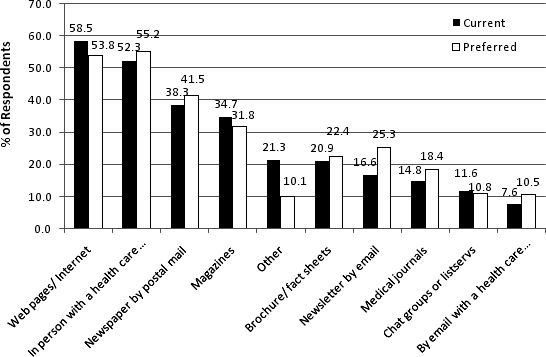
Current and preferred ways (Formats) to receive SCI information.
Figure 2.

Current and preferred sources of SCI information.
Table 2.
SCI Topics That Respondents Needed Information on the Most Within the Last 6 Months
Table 3.
Predictors of Web Pages/Internet as 1 of Top 3 Current Ways to Get SCI Information
The categories books, public libaries, and research libraries were not included in the figure because less than 10% of respondents selected these options for current and preferred ways to received SCI information. The category occupational therapist was not included in the figure because less than 10% of respondents selected these options for current and preferred source of SCI Information.
SCI Topics
Respondents reported needing information on medical issues the most within the last 6 months, with 42.2% ranking medical issues as the most sought-after topic, and 65.0% ranking it within the top 3 topics. Other topics frequently selected within the top 3 included fitness/health promotion/nutrition (29.2%), SCI cure (29.2%), and improving my level of physical function (28.5%). As expected, those who selected physician: SCI expert/rehabilitation specialist as their preferred information source were 2.3 times (P < 0.05) more likely to also select medical issues within their list of top 3 topics they needed information on in the past 6 months (Table 4).
Table 4.
Predictors of Web Pages/Internet as 1 of the Top Three Preferred Ways to Get SCI Information
Internet Access
According to our results, 80.2% of respondents reported having in-home Internet access. Bivariate logistical regression showed that, for each increase in education level, respondents had 2.1 times (P < 0.001) higher odds of having in-home Internet access and 1.9 times (P < 0.001) higher odds for each increase in income level. Those who identified as “non-Hispanic white” had 3.0 times (P < 0.001) higher odds of having in-home Internet access.
Assistance
We asked participants whether they used assistive technology or required assistance from someone else to access the Internet. A total of 71.8% of respondents reported that they did not use accommodations or assistance; 8.3% reporting using only assistive technology, whereas 7.2% reported only assistance from someone else to access the Internet. A small percentage (1.8%) reported both using assistive technology and needing assistance from someone else, and 10.8% did not respond.
Multivariate Analyses: Web Pages/Internet
Web pages/Internet was the most frequently top-ranked current and preferred way to receive SCI information. To understand the relationship among demographic variables such as race and income with information use and preferences, multivariate logistic regression analyses were conducted. The models with best overall fit (P < 0.05) are presented [as recommended by Peng et al (19)] in Tables 5 and 6, and the results are described below.
Table 5.
Current and Preferred Ways (Formats) to Receive SCI Information by Ranking
Table 6.
Current and Preferred Source of SCI Information by Ranking
After controlling for the other demographic covariates (including in-home Internet access), race, education, and age were statistically significant predictors of whether someone was currently using the Internet to obtain SCI information (Table 5). Respondents who identified themselves as “non-Hispanic white” were estimated to be 2.2 times more likely than those from other racial/ethnic groups to currently use the Internet to access SCI information. With each increase in education level, participants were 1.8 times more likely to use the Internet currently for SCI information. Age remains a significant predictor of Internet use, but the odds are close to 1 (0.97), meaning for every 1-year decrease in age, respondents were 0.97 times more likely to currently use the Internet. Age is thus significant but not a substantial predictor.
Similarly respondents identifying themselves as “non-Hispanic white” were estimated to be 2.2 times more likely than those from other racial/ethnic groups to prefer using the Internet to obtain SCI information (Table 6). With each increase in education level, participants were 1.5 times more likely to prefer the Internet for SCI information. As in the model predicting current Web page/Internet use, age remains a significant but not substantial predictor, the odds are close to 1 (0.98) and only decrease in 1-year increments. While controlling for other demographic covariates (including in-home Internet access), race/ethnicity and education are the predictors most likely to influence whether someone prefers using the Internet to obtain SCI information.
Limitations
Our study sample may not be representative of the national SCI population; it seems to have a higher percentage of individuals who are women and “non-Hispanic white” than the national SCI population (1). Examples of sample data that differ from national data include sex (male, 62.8%; nationally, 77.8%) and ethnicity/race (white, 84.4%; nationally, 63.0%). Nonrepresentativeness may partially be explained by a high percentage of cases coming from 2 of the 10 US regions, specifically from the states of Washington and Georgia. This limitation is a significant concern given our results that individuals from minority racial/ethnic groups are less likely to have access to the Internet and use Web pages/Internet for their current and preferred way to receive SCI information. An additional limitation of the survey design is that not all the categories are mutually exclusive. For example, a journal can be accessed through the Internet. This may have caused confusion for some respondents.
DISCUSSION
The high level of Internet access found in this study (80.2% of respondents reported having in-home Internet access) is supported by previous research findings in which people with lower incomes, less education, and/or from ethnic minority groups reported significantly less computer and Internet access (16,20). We found that educational level and race predicted current and preferred use of the Internet for obtaining SCI information, suggesting that some groups may be difficult to distribute SCI information to through the Internet. Therefore, it continues to be necessary to distribute information in a variety of formats and not rely exclusively on Web-based dissemination.
Goodman et al (20) additionally reported that 19.1% of participants used some form of assistive technology with the computer. We found that 10.5% of respondents used assistive technology, and 9.0% needed assistance from someone else to access the Internet. People who use assistive technology require electronic and information technology that are accessible (ie, meet Section 508 standards and WCAG 2.0 guidelines). Accessibility should be an important criterion in the development of electronic materials.
Previous research (13) supports our finding that medical issues related to SCI is the most important information topic for individuals with SCI. However, this result may be influenced by the questions earlier in the survey that inquired about current and preferred information sources because many of the response options were professionals within a medical setting. It is notable that 70.4% of respondents selected physician: SCI expert/rehabilitation specialist as 1 of their top 3 preferred sources of SCI information and were 2.3 times more likely to also select medical issues within their list of top 3 topics they needed information about in the past 6 months. Regardless, medical issues were identified as the most important topic regardless of age or other demographic variables.
Although Web pages/Internet was the most used current source of information, more respondents reported in person w/health care provider as their most preferred source. This suggests that the Internet is commonly used because it is frequently available (also noted in reference 2), whereas access to health care providers may be more difficult and less frequent. In particular, health care providers who are SCI experts are rated as 1 of the top 3 preferred sources of information for individuals with SCI by more than 70% of respondents, whereas only 50% reported SCI experts as their current source. Burkell et al (2) also described SCI experts as often inaccessible. In summary, our results confirm that, whereas those with SCI prefer to receive SCI information (most specifically information related to medical issues) from SCI experts, the Internet is a more available source.
CONCLUSION
Further research is needed to answer a number of questions. It would be useful to identify the specific medical issues about which individuals with SCI need information. It may be that information about important medical issues does not exist and needs to be developed. Or it may be that the information does exist but is not easily accessible to consumers (eg, targeted toward professionals only). It is also important to identify more clearly if and how information needs change after injury and over time.
Further research is also needed to identify the most effective method of providing SCI information to those less likely to prefer Web pages/Internet as their primary source of SCI information including individuals with lower levels of education and from under-represented backgrounds. The Internet is becoming a primary means of dissemination because of the ease of publishing and the low cost associated with delivering information. However, research and consumer organizations will need to plan for alternative ways to adequately target information to certain groups of individuals with SCI.
Finally, research is needed to identify barriers to accessing SCI experts and propose solutions to increase access to them. Consumers with SCI clearly prefer to get information from individuals they perceive to be experts on the topic of SCI. We need to identify whether people with SCI prefer to talk with an expert because they feel the information is more likely to be accurate. If so we might be able to meet this need in a cost-effective way. One possibility is to test the feasibility and effectiveness of providing information from SCI experts through the Internet (eg, on a Website). If the interactive nature of talking to a person is part of what is valued by individuals with SCI, perhaps providing an option to “Ask a Doctor” might be more desired.
Appendix A: Information Sources
The following questions ask about the information sources people with SCI use when seeking to learn more about their condition or related issues.
-
1
From the list below, please rank the top 3 ways that describe how you currently receive SCI information. Place a 1, 2, and 3 in the spaces next to your first, second, and third choices, respectively. Please rank up to 3 choices.
-
2
From the list below, please rank the top 3 ways that describe how you prefer to receive SCI information. Place a 1, 2, and 3 in the spaces next to your first, second, and third choices, respectively. Please rank up to 3 choices.
-
3
From the list below, please rank the top 3 ways that describe who you currently receive SCI information from. Place a 1, 2, and 3 in the spaces next to your first, second, and third choices, respectively. Please rank up to 3 choices.
-
4
From the list below, please rank the top 3 ways that describe who you prefer to receive SCI information from. Place a 1, 2, and 3 in the spaces next to your first, second, and third choices, respectively. Please rank up to 3 choices.
-
5
From the list below, please rank the top 3 SCI topics you have needed information on the most within the last 6 months. Place a 1, 2, and 3 in the spaces next to your first, second, and third choices, respectively. Please rank up to 3 choices.
-
6
Please describe your current access to the Internet (check one):
___ In-home high-speed Internet such as DSL/Cable/WiFi
___ In-home low-speed Internet such as dial-up
___ Out of home access to the Internet (friend, library, cyber-cafe)
___ Very limited access to the Internet
___ No access to the Internet
-
7
When you access the internet (check all that apply):
___ I do not use accommodations or assistance
___ I use assistive technology
___ I have assistance from another individual
Footnotes
This work was funded by the National Institutes of Health grant to University of Washington, the NIH Roadmap for Medical Research (Grant 5U01AR052171-03); and the National Institute for Disability and Rehabilitation Research grant to the University of Washington Model Systems Knowledge Translation Center (Grant H133A060070).
REFERENCES
- National Spinal Cord Injury Statistical Center. Spinal Cord Injury: Facts and Figures at a Glance. Available at: http://images.main.uab.edu/spinalcord/pdffiles/Facts08.pdf. Accessed July 10, 2008.
- Burkell JA, Dalton LW, Potter PJ, Jutai JW. Information needs and information sources of individuals living with spinal cord injury. Health Inf Libr J. 2006;23(4):257–265. doi: 10.1111/j.1471-1842.2006.00686.x. [DOI] [PubMed] [Google Scholar]
- McKinley WO, Jackson AB, Cardenas DD, DeVivo MJ. Long-term medical complications after traumatic spinal cord injury: a regional model systems analysis. Arch Phys Med Rehabil. 1999;80(11):1402–1410. doi: 10.1016/s0003-9993(99)90251-4. [DOI] [PubMed] [Google Scholar]
- Chen Y, DeVivo MJ, Jackson AB. Pressure ulcer prevalence in people with spinal cord injury: age-period-duration effects. Arch Phys Med Rehabil. 2005;86(6):1208–1213. doi: 10.1016/j.apmr.2004.12.023. [DOI] [PubMed] [Google Scholar]
- Davidoff G, Roth EJ, Richards JS. Cognitive deficits in spinal cord injury: epidemiology and outcome. Arch Phys Med Rehabil. 1992;73(3):275–284. [PubMed] [Google Scholar]
- Bombardier CH, Richards JS, Krause JS, Tulsky D, Tate DG. Symptoms of major depression in people with spinal cord injury: implications for screening. Arch Phys Med Rehabil. 2004;85(11):1749–1756. doi: 10.1016/j.apmr.2004.07.348. [DOI] [PubMed] [Google Scholar]
- Cardenas DD, Hoffman JM, Kirshblum S, McKinley W. Etiology and incidence of rehospitalization after traumatic spinal cord injury: a multicenter analysis. Arch Phys Med Rehabil. 2004;85(11):1757–1763. doi: 10.1016/j.apmr.2004.03.016. [DOI] [PubMed] [Google Scholar]
- Byrne DW, Salzberg CA. Major risk factors for pressure ulcers in the spinal cord disabled: a literature review. Spinal Cord. 1996;34(5):255–263. doi: 10.1038/sc.1996.46. [DOI] [PubMed] [Google Scholar]
- Barker RN, Kendall MD, Amsters DI, Pershouse KJ, Haines TP, Kuipers P. The relationship between quality of life and disability across the lifespan for people with spinal cord injury. Spinal Cord. 2008;47(2):149–155. doi: 10.1038/sc.2008.82. [DOI] [PubMed] [Google Scholar]
- Kroll T, Neri M, Ho P. Secondary conditions in spinal cord injury: results from a prospective survey. Disabil Rehabil. 2007;29(15):1229–1237. doi: 10.1080/09638280600950603. [DOI] [PubMed] [Google Scholar]
- Zemper ED, Tate DG, Roller S. Assessment of a holistic wellness program for person with spinal cord injury. Am J Phys Med Rehabil. 2003;82(12):957–968. doi: 10.1097/01.PHM.0000098504.78524.E2. [DOI] [PubMed] [Google Scholar]
- May L, Day R, Warren S. Perceptions of patient education in spinal cord injury rehabilitation. Disabil Rehabil. 2006;28(17):1041–1049. doi: 10.1080/09638280500494744. [DOI] [PubMed] [Google Scholar]
- Hart KA, Rintala DH, Fuhrer MJ. Educational Interests of individuals with spinal cord injury living in community: medical, sexuality, and wellness. Top Rehabil Nurs. 1996;21(2):82–90. doi: 10.1002/j.2048-7940.1996.tb01681.x. [DOI] [PubMed] [Google Scholar]
- Gontkovsky ST, Russum P, Stokic DS. Perceived information needs of community-dwelling persons with spinal cord injury: findings of a survey and impact of race. Disabil Rehabil. 2007;29(16):1305–1312. doi: 10.1080/09638280600964364. [DOI] [PubMed] [Google Scholar]
- Hauber R, Vesmarovich S, Dufour L. The use of computers and the Internet as a source of health information for people with disabilities. Rehabil Nurs. 2002;27(4):142–145. doi: 10.1002/j.2048-7940.2002.tb02222.x. [DOI] [PubMed] [Google Scholar]
- Drainoni ML, Houlihan B, Williams S. Patterns of Internet use by persons with spinal cord injuries and relationship to health-related quality of life. Arch Phys Med Rehabil. 2004;85(11):1872–1879. doi: 10.1016/j.apmr.2004.07.350. [DOI] [PubMed] [Google Scholar]
- Edwards L, Krassioukov A, Fehlings MG. Importance of access to research information among individuals with spinal cord injury: results of an evidenced-based questionnaire. Spinal Cord. 2002;40(10):529–535. doi: 10.1038/sj.sc.3101364. [DOI] [PubMed] [Google Scholar]
- Jensen MP, Hoffman AJ, Cardenas DD. Chronic pain in individuals with spinal cord injury: a survey and longitudinal study. Spinal Cord. 2005;43(12):704–712. doi: 10.1038/sj.sc.3101777. [DOI] [PubMed] [Google Scholar]
- Peng C, Lee K, Ingersoll G. An introduction to logistic regression analysis and reporting. J Educ Res. 2002;96(1):3–14. [Google Scholar]
- Goodman N, Jette AM, Houlihan B, Williams S. Computer and internet use by persons after traumatic spinal cord injury. Arch Phys Med Rehabil. 2008;89(8):1492–1498. doi: 10.1016/j.apmr.2007.12.038. [DOI] [PubMed] [Google Scholar]




